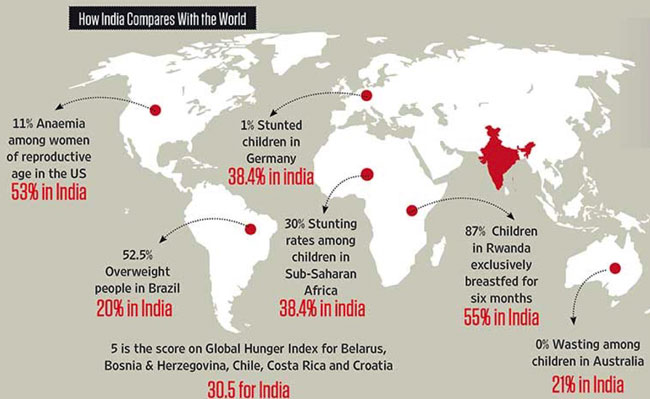As the economist T. N. Srinivasan observes, these wide disparities meant that “if one is poor in India … one is more likely to live in rural areas, more likely to be a member of the Scheduled Caste or Tribe or other socially discriminated group, more likely to be malnourished, sick and in poor health, more likely to be illiterate or poorly educated and with low skills, more likely to live in certain states (such as … Bihar, Madhya Pradesh, Rajasthan and Uttar Pradesh, and also Orissa) than in others … “
One consequence of these disparities is the growing migration from poorer areas to richer ones. Once, most Indians lived, worked and died in the vicinity of their place of birth. Now, they increasingly travel long distances in search of a living. Labourers from Orissa come to work on coffee plantations in the Coorg district of Karnataka, 1,000 miles away. […]
Economic growth in contemporary India is marked by considerable disparities of region and class. The Nobel-prize-winning economist Amartya Sen worries that, as these inequalities intensify, one half of India will come to look and live like California, the other half like sub-Saharan Africa. [Quoted in an interview in India Today, 20 February 2006] Already, prosperity co-exists with misery, technological sophistication with human degradation. The paradoxes of life in India were tellingly captured in a conversation between the prime minister and villagers in Orissa that took place in September 2001. From his home in New Delhi, Atal Behari Vajpayee spoke by satellite to tribals in Kashipur, whose kinsmen had died after eating mango kernel because their crops had failed. ‘It is extremely unfortunate that in today’s world people die by eating poisonous material’, said the head of a government that could speak to its citizens by videophone, yet not supply them with wholesome food.
Source: Ramachandra Guha. India after Gandhi: The History of the World’s Largest Democracy. Picador India, 2011, p. 711
“The tribal households traditionally had a backyard garden that had multiple, multilayered and multipurpose indigenous trees, plants, herbs, and shrubs. […] The produce from this small garden was sufficient to meet the dietary and nutrition needs of a family for an entire year.” – Learn more about food crops that are resistant to pests, grow on poor soils, flourish under changed climatic conditions and offer high nutritive value | Food distribution >>

Reflections on Adivasi Silence and Voice by Ganesh [G.N.] Devy | Publications >>
A call for harnessing the potential of Denotified Tribes, Nomadic and Semi-Nomadic Tribes for national development: “India’s labour force must be liberated from an abhorrent colonial doctrine (‘criminality by birth’)” – Report and Recommendations of the Technical Advisory Group | “Adivasi”, “Tribals” and “Denotified tribes” (classifications in different states) >>

Graphic © Outlook India 26 August 2019 | Enlarge >>
“The tribal food basket has always been diverse and nutritious” >>
“Health spending by the Indian government as percentage of GDP has long been one of the lowest for any major country, and the public health system is chronically dismal.” – Pranab Bardhan in “The two largest democracies in the world are the sickest now” | Learn more: Scroll.in, 24 August 2020 >>
Reports in the Indian press | List of periodicals included in this search >>
Search tips
Combine the name of any particular state, language or region with that of any tribal (Adivasi) community.
Add keywords of special interest (music, poetry, dance just as health, sacred grove and biodiversity); learn about the rights of Scheduled Tribes such as the “Forest Rights Act” (FRA); and the United Nations “Declaration on the Rights of Indigenous Peoples”, “Universal Declaration of Human Rights”, “women’s rights”, or “children’s right to education”.
Specify any other issue or news item you want to learn more about (biodiversity, bonded labour and human trafficking, climate change, ecology, economic development, ethnobotany, ethnomedicine, global warming, hunter-gatherers in a particular region or state, prevention of rural poverty, water access).
For official figures include “scheduled tribe ST” along with a union state or region: e.g. “Chhattisgarh ST community”, “Himalayan tribe”, “Scheduled tribe Tamil Nadu census”, “ST Kerala census”, “Particularly Vulnerable Tribal Group Jharkhand”, “PVTG Rajasthan”, “Adivasi ST Kerala”, “Adibasi ST West Bengal” etc.
In case the Google Custom Search window is not displayed here try the following: (1) toggle between “Reader” and regular viewing; (2) in your browser’s Security settings select “Enable JavaScript” | More tips >>
Note: hyperlinks and quotes are meant for fact-checking and information purposes only | Disclaimer >>
Find publications by reputed authors (add “open access” for freely downloadable content)
PDF-repository: texts quoted & further reference (Google Drive) >>
Learn more
Bondage | Bonded labour | Human trafficking | Slavery | Zamindari
Childhood | Childrens rights: UNICEF India | Safe search
Colonial policies | Freedom Struggle | Independence
Denotified Tribe vs. “criminal tribe“
Figures, census and other statistics
Health and nutrition | Recommendations by the Expert Committee
“In fact, we still do not know to what extent global supply chains are maintained by slavery and child labor. Because of these and other factors, slavery today is more profitable than ever before, and also more woven into the global economy than ever before.” – Siddharth Kara on the persistence of modern slavery| Learn more >>
Human trafficking is a crime. To report in India, call
– Shakti Vahini +91-11-42244224, +91-9582909025 or
– Childline 1098 (national helpline)
Human Rights Commission (posts) | www.nhrc.nic.in (Government of India) >>
